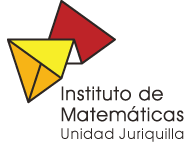Searching for snarks with symmetry: a work in progress
Institución: University of Alaska Fairbanks
Tipo de Evento: Investigación
| Cuándo |
26/04/2016 de 17:00 a 18:00 |
|---|---|
| Dónde | Unidad Multidisciplinaria de Docencia e Investigación (UMDI), Aula 2. UNAM Campus Juriquilla, Querétaro |
| Agregar evento al calendario |
|
A graph is properly edge colored if you assign colors to the edges of the graph so that if two edges have a common vertex, the two edges have different colors. The chromatic index of a graph is the smallest number of colors needed to properly edge color the graph. At its most basic, snark is a cubic graph whose chromatic index is greater than 3 (although sometimes people put further restrictions to be considered a “proper” snark, such as requiring the snark to be bridgeless, or have a certain girth or a certain kind of connectivity) — a well known example is, of course, the Petersen graph, which requires four colors for a proper edge-coloring. It turns out that snarks are hard to find! Initial investigations in the 1970s focussed simply on finding examples, while investigations in the last 15 years or so have focussed on showing snarks with certain properties exist. In this talk, I will tell you about a current investigation, where we are trying to find and generalize lots of infinite families of snarks which can be embedded in the plane with m-fold rotational symmetry. Our technique involves the idea of constructing snarks as Z_m lifts of voltage graphs constructed in a specific way from smaller graphs. We will present at least one truly new embedding of a snark on 34 vertices, which leads to a new infinite family of snarks, as well as reanalyzing snarks that can be viewed as coming from a previously known construction technique (although the particular examples seem to not be known).

